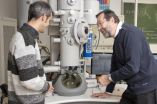(Press-News.org) The largest volcanic eruption on Earth in the past millions of years took place in Indonesia 74,000 years ago and researchers from the Niels Bohr Institute can now link the colossal eruption with the global climate and the effects on early humans. The results are published in the scientific journal Climate of the Past.
The volcano Toba is located in Indonesia on the island Sumatra, which lies close to the equator. The colossal eruption, which occurred 74,000 years ago, left a crater that is about 50 km wide. Expelled with the eruption was 2,500 cubic kilometers of lava – equivalent to double the volume of Mount Everest. The eruption was 5,000 times larger than the Mount St. Helens eruption in 1980 in the United States. Toba is the largest volcanic eruption on Earth in the last 2 million years.
The volcanic eruption threw huge clouds of ash and sulphuric acid into the atmosphere and up into the stratosphere, from where it spread across the entire globe in both the northern and southern hemispheres and fell down as acid rain.
Traces of acid rain in the ice caps
"We have now traced this acid rain in the ice caps on Greenland and Antarctica. We have long had an idea of at what depth the Toba eruption could be found in the Greenland ice cap, but we found no ash, so we could not be sure. But now we have found the same series of acid layers from Toba in the Greenland ice sheet and in the ice cap in Antarctica. We have counted the annual layers between acid peaks in ice cores from the two ice caps and it fits together," explains glaciologist Anders Svensson, Centre for Ice and Climate at the Niels Bohr Institute at the University of Copenhagen.
"This means that we can compare the ice cores from Greenland and Antarctica with a annual accuracy and thus combine our knowledge of climate change in the northern and southern hemispheres," emphasizes Anders Svensson.
There has been much speculation about how such a huge eruption affected the climate. The giant clouds of sulphur particles that are thrown up into the stratosphere form a blanket that shields from the sun's radiation and this causes the Earth to cool. But how much and for how long? Modelling has shown that such an enormous eruption could cause a cooling of up to 10 degrees in the global temperature for decades..
"In the temperature curves from the ice cores we can see that there is no general global cooling as a result of the eruption. There is certainly a cooling and large fluctuations in temperature in the northern hemisphere, but it becomes warmer in the southern hemisphere, so the global cooling has been short," says Anders Svensson.
Consequences for man
But the eruption may still have had major consequences for nature, the environment and humans in large areas of Asia, where a clear layer of ash from the eruption has been found.
The eruption occurred at a fateful time in human history, around the time when there was a mass exodus of our ancestors, Homo sapiens, from Africa to Asia and researchers believe that early people living as far as 2000 km away in eastern India were affected by the eruption, which raged for weeks.
Archaeologist, however, strongly disagree about what the consequences of the Toba eruption were for people living in the areas of Asia that were affected by the eruption. Speculation ranges from almost no effect to total or partial extermination of the population in large areas. Material from this period is too old to be dated using the carbon-14 method and the Toba ash layer is therefore a very important reference horizon.
"The new precise location of the Toba eruption in the ice cores will place the archaeological finds in a climatic context, which will help to shed light on this critical period of human history," says Anders Svensson.
INFORMATION:
Article in Climate of the Past: http://www.clim-past-discuss.net/8/5389/2012/
For more information contact:
Anders Svensson, Geophysicist, Ph.D. Centre for Ice and Climate, Niels Bohr Institute, University of Copenhagen.+45 3532-0616, +45 4038-4410, as@gfy.ku.dk
http://www.nbi.ku.dk/english/
Massive volcanic eruption puts past climate and people in perspective
2012-11-05
ELSE PRESS RELEASES FROM THIS DATE:
Crystals for efficient refrigeration
2012-11-05
Washington, D.C.--Researchers at the Carnegie Institution have discovered a new efficient way to pump heat using crystals. The crystals can pump or extract heat, even on the nanoscale, so they could be used on computer chips to prevent overheating or even meltdown, which is currently a major limit to higher computer speeds. The research is published in the Physical Review Letters.
Ronald Cohen, staff scientist at Carnegie's Geophysical Laboratory and Maimon Rose, originally a high school intern now at the University of Chicago carried out the research. They performed ...
More mobility – Due to deafferentation
2012-11-05
In the 'Journal of Neuroscience' (DOI:10.1523/JNEUROSCI.5912-11.2012) the researchers present the results of their study, showing how a local anesthetic can distinctly improve the motor skills of patients after a stroke.
"Many stroke patients suffer from chronic impairment of the hand or of the complete arm," Professor Dr. Thomas Weiss explains. Together with expert colleagues the psychologist of the department of Biological and Clinical Psychology at Jena University has been working for a number of years on a specialized medical training therapy which clearly enhances ...
Researchers make strides toward selective oxidation catalysts
2012-11-05
Oxide catalysts, typically formulated as powders, play an integral role in many chemical transformations, including cleaning wastewater, curbing tailpipe emissions, and synthesizing most consumer products.
Greener, more efficient chemical processes would benefit greatly from solid oxide catalysts that are choosier about their reactants, but achieving this has proven a challenge. Now researchers from Northwestern University and Argonne National Laboratory have developed a straightforward and generalizable process for making reactant-selective oxide catalysts by encapsulating ...
Scientists find Achilles’ heel of cancer cells
2012-11-05
Several substances inhibiting so-called HDAC enzymes have been studied in trials searching for new anti-cancer drugs in recent years. "Trials have shown that HDAC inhibitors are very effective in arresting growth of cultured cancer cells. But apart from a very rare type of lymphoma, these drugs unfortunately do not clinically affect malignant tumors," says Prof. Dr. Olaf Witt, who heads a research department at DKFZ and is pediatrician at the Center for Child and Adolescent Medicine of Heidelberg University Hospital.
In the cell, histone deacetylases (HDAC) are responsible ...
Many patients who die while awaiting liver transplant have had donor organs declined
2012-11-05
The majority of patients on the liver transplant waitlist who died received offers of high-quality donated livers that were declined prior to their death, according to a new study in Gastroenterology, the official journal of the American Gastroenterological Association. Therefore, efforts other than simply increasing the availability of donated livers or the number of offers are needed to substantially reduce the deaths among those waiting for a transplant.
"Our findings suggest that waitlist deaths are not simply due to lack of donor organs, as many of us assume. Rather, ...
Women's body talk: Perception stronger than reality?
2012-11-05
How women think their friends feel about their bodies influences their own body concerns, according to a new study by Dr. Louise Wasylkiw and Molly Williamson from Mount Alison University in Canada. Their work, which examines the role of friends in young women's body concerns, is published online in Springer's journal Sex Roles.
Research shows that friends influence how girls and women view and judge their own body weight, shape and size. What Wasylkiw and Williamson's work sheds light on, is how much of a young woman's body concerns are shaped by her perceptions of ...
Build your own home theater for full-blast entertainment with 'Virtual Sound Ball'
2012-11-05
Daejeon, Republic of Korea, November 5th, 2012—Watching a 3 dimensional (3D) film at home can be just as real and fun as going to a movie theater. Professor Yang-Hann Kim and Research Professor Jung-Woo Choi from the Department of Mechanical Engineering, KAIST, have succeeded in building an audio rendering system that will considerably improve the current 3D audio effects technology.
3D audio effects can be produced by stereo speakers, surround-sound speakers, speaker-arrays, or headphones, which essentially give an illusion to listeners that sounds are being produced ...
Sensors for the real world
2012-11-05
Over the last decade there has been an increased interest in developing resonators for gravitmetric sensing; however, the sensors' response to variations in temperature has prevented them from being used outside the laboratory. New sensors developed by researchers at the University of Cambridge negate the effects of temperature so that they may be used in industries including health care, telecommunications and environmental monitoring.
Sensors built from high frequency bulk acoustic wave (BAW) resonators consist of a piezoelectric layer sandwiched between two electrodes, ...
Electron microscopes with a twist
2012-11-05
This press release is available in German.
Nowadays, electron microscopes are an essential tool, especially in the field of materials science. At TU Vienna, electron beams are being created that possess an inner rotation, similarly to a tornado. These "vortex beams" cannot only be used to display objects, but to investigate material-specific properties - with precision on a nanometer scale. A new breakthrough in research now allows scientists to produce much more intense vortex beams than ever before.
Quantum Tornado: the Electron as a Wave
In a tornado, the individual ...
High-strength material advancements at Wayne State University may lead to new, life-saving steel
2012-11-05
DETROIT— There has been great advancements in the development of the high-strength steel and the need for additional enhancements continue to grow. Various industries have a need for structural components that are lighter and stronger, improve energy efficiencies, reduce emissions and pollution increase safety and cost less to produce, particularly in the automotive industry.
A group of researchers in Wayne State University's College of Engineering have been working to create advanced materials with high-yield strength, fracture toughness and ductility. Their efforts ...




